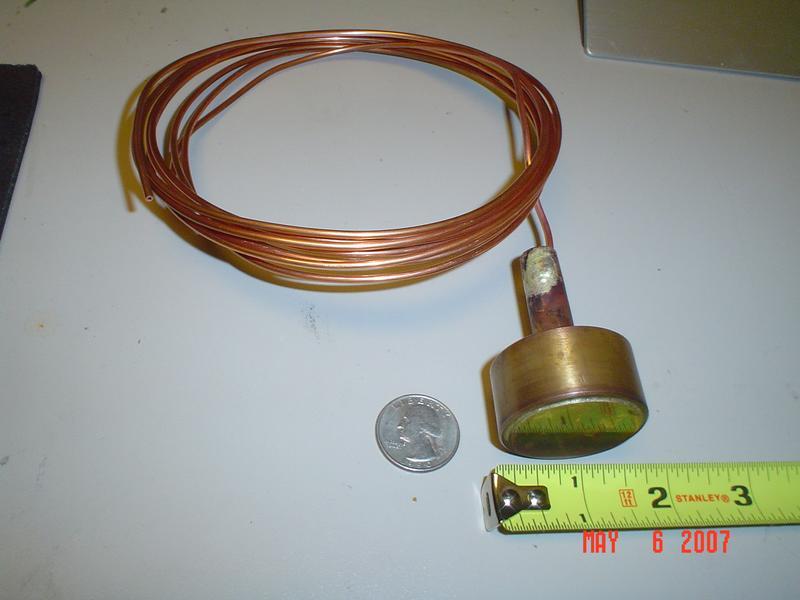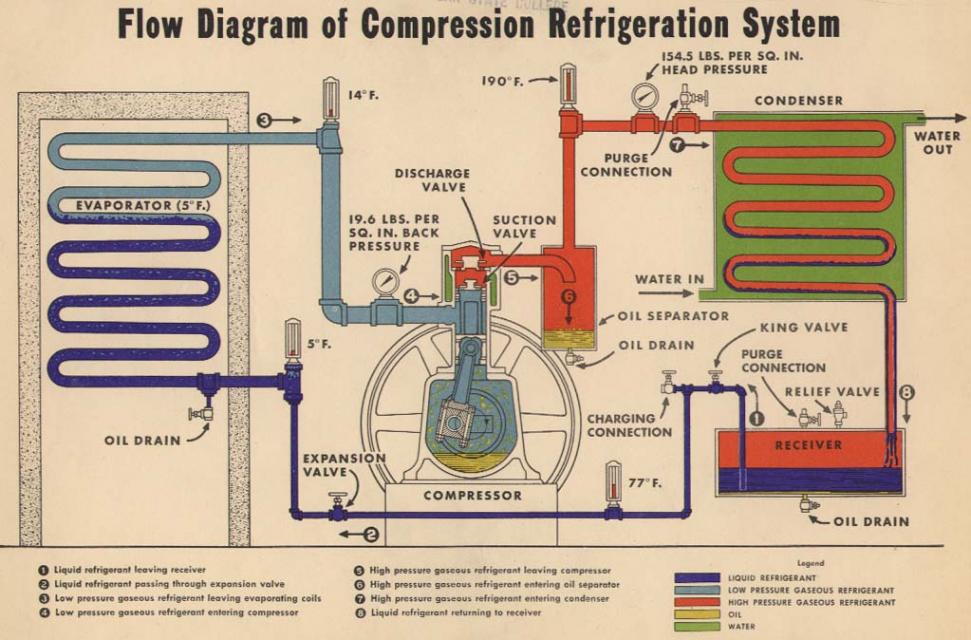Before we open up our Air Conditioner, it would be a good idea to consider how the thing works, so that we will have some appreciation for the stuff we're going to be looking at and in some cases modifying.
EDIT: 1-28-2012
It is useful to get info from several sources.
Here in an excellent explanation of how refrigeration works from a seasoned HVAC guy,
originally posted here.
END OF EDIT: 1-28-2012
I have talked to lots of people, modern people, who just can't understand why I think I can use a refrigeration compressor (actually Air Conditioner compressor), which they associate with cold, and to bury pipes in the ground, which they also associate with cold, and reasonably expect that this procedure will result in making my house warm. I've tried to use refrigerators as an example, which they associate with cold, to explain the process, and I usually get to see people with pitying eyes stare at me, wondering how an otherwise reasonable person could be so misled.
But I'll try again here...
First off, what is heat?
We have an intuitive notion that heat is what we feel when we touch something that is warmer than our hand. And the opposite, cold is what we feel when we touch something that is less warm than our hand.
If we look really deeply into the question of what heat is, we will find out that heat is actually a manifestation of energetic movement of molecules. The greater the movement, the greater the heat. But something what might feel cold to us, like cold water, in fact has this energetic molecular movement that results in heat. It may have less energetic movement than warm water, but it still has energetic movement.
In fact, any material will have this energetic movement that we will call heat until the very cold temperature of −459.67°F. SO compared to that the temperature of the ground is pretty warm.
Let's look at this refrigeration diagram:
This is a simplified diagram of the components in the refrigeration cycle of our air conditioner. I have taken the liberty of adding the light green line to the diagram from the compressor across to the "valve" (AKA: metering device, expansion valve, capillary tubing, etc.). This green line marks the boundary between the high pressure side (AKA: high side, pressure side, hot side) which is on the right side of our diagram, and the low pressure side (AKA: low side, suction side, cold side) which is on the left side of our diagram.
This whole refrigerant circuit is hermetically sealed from atmospheric pressure, it is in it's own special refrigeration world, there's no water in there, there's no dirt in there, just refrigerant and some lubricant. Before we power up the compressor, the pressure of the refrigerant gas/liquid on both sides of the diagram is under greater than atmospheric pressure (probably in the range of 50 to 100 psi), but it is equalized on both sides. Neither side is hotter or colder than the other.
When we put power to the unit, we intentionally create an imbalance and we exploit the changes that result from this imbalance.
There may be a bit of a time delay, but very soon, the compressor starts working and it begins discharging refrigerant gasses out of the compressor and sending them through the high-pressure side tubing. They travel through this tubing until they get to the "valve" where their progress is slowed almost to a standstill. But the compressor continues pumping away and the gasses back up and the pressure increases and so does the heat of the gases and at some point, the gasses are under so much pressure that they almost begin to turn into a liquid, a hot liquid. This hot, highly pressurized gas then flows through an assembly which allows for the removal of some of the heat. This assembly is called the condenser. When enough heat is removed, the hot gasses in the condenser actually do turn into liquid, and in so doing they yield up an accellerated amount of heat. (* This gives us a thermal imbalance that we can exploit to make our heat pump. This thermal imbalance is where the heat that we desire to heat our house or our water is extracted. But where does it come from? Read on...) The hot liquid then moves along to the expansion valve.
The expansion valve in small air conditioners usually takes the form of what is known as a 'capillary tube', or 'cap tube' in the trade. This cap tube uses the friction created by both a very small diameter, and a relatively long length to consistently restrain the flow of liquid refrigerant in the circuit. The cap tube is reliable, fairly consistent and cheap. The cap-tube is designed to work with our compressor, so we'll want to salvage it when we begin major surgery.
Loook at the second picture:
 cap-tube.jpg
cap-tube.jpg
So the liquid flows in a restrained manner through the cap tube, which may be 4 to 8 leet in length, all coiled up, inside our air conditioner. Then something strange and wonderful happens...
While the compressor has been feverishly creating a high-pressure condition on the right side of our diagram, it has also been feverishly creating a low-pressure condition on the other side of the diagram.
As the refrigerant travels through the cap tube, at some point very near the exit of the cap tube (less than an inch) it enters the low pressure created by the compressor. When this liquid enters the low pressure area, the imbalance of pressures force the liquid to instantly flash into vapor. (* This instantaneous flashing into vapor causes an instantaneous drop of temperature. Here we have another thermal imbalance which we will also exploit in our heat pump. This extraordinary imbalance, cold in this case creates a thermal "vacuum" into which heat from surrounding earth or water will flow. *)
Look at the third picture:
 frost formation
frost formation
I'm also posting another diagram of a refrigeration circuit. It's really a great illustration, and you should be able now to understand just what's going on in this picture.
 refrigeration-illustration
refrigeration-illustration
& & & & & & & & & & & & & & & & & &
As an addition, here are some documents that also introduce the principles of refrigeration:
And here is a clear, plain-english
description of the refrigeration process.
And here is
an information packed index page leading on to amazing projects by people determined to wring extra performance out of their computers by using refrigeration technology to cool down over-clocked CPUs.
Best Regards,
-AC_Hacker